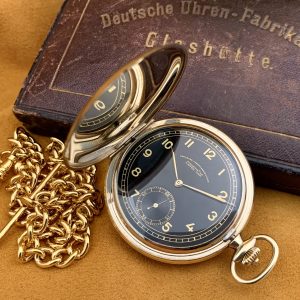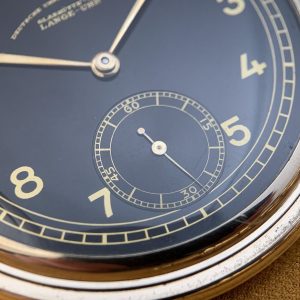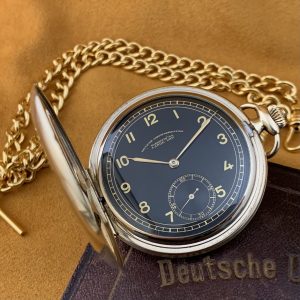“The entire pursuit of a watchmaker should be the perfection of each and every watch” – F. A. Lange
A. Lange & Söhne is a luxury watchmaking company based in Glashütte, Germany. Founded in 1845 by Ferdinand Adolph Lange, the company has a long, tumultuous and prestigious history of creating high-quality, precision timepieces. In this story, we will explore the history of A. Lange & Söhne and how the company laid the foundations for German fine watchmaking.
Ferdinand Adolph Lange (1915 – 1875)
Ferdinand Adolph Lange was born in Dresden, Germany in 1815. After his parents separated, Lange was adopted by a foster family at a young age, who provided him with the opportunity to receive a proper education. In 1829, he enrolled at the technical school in Dresden, where he studied six days a week, splitting his time between theoretical work and manual craftwork. At the age of 15, Lange was apprenticed to the acclaimed court watchmaker Johann Christian Friedrich Gutkaes (shown to the left of Lange in the image above), who quickly recognized and encouraged his young protégé’s watchmaking talent.
After graduating from his apprenticeship with honors in 1835, Lange worked as an assistant to Gutkaes for over two years. However, Lange had bigger aspirations and wanted to further improve his skills as a watchmaker. In 1837, he set off on a journey to learn from the best in the industry, traveling to Switzerland, England, and France. In Paris, he spent four years working with the renowned master watchmaker Winnerl, a former apprentice of Abraham-Louis Breguet. Lange eventually became the foreman at Winnerl’s workshop, where he wrote his famous notebook with drawings of mechanisms and extensive gear ratio calculations, which demonstrates his exceptional thirst for knowledge.

F. A. Lange’s notebook with gear ratio calculations
Very pleased with Lange’s work, Winnerl offered him the opportunity to stay and continue working with him. But Lange had different plans and declined the offer. His old teacher Gutkaes had written a letter to Lange before his journey, saying: “don’t forget your home, don’t forget your people”. With this in mind he returned to Dresden in 1841 at the age of 26. The following year Lange married the daughter of Gutkaes, Charlotte Amalie Antonia, and became co-owner and the chief designer of watches for Gutkaes’ business, which was now called Gutkaes & Lange. It was during this time that Lange revealed his lifelong ambition: to bring prosperity to the Saxon region by establishing a watchmaking industry that manufactures the finest watches in the world.
In order to pursue his dream, Lange needed financial support. He therefore wrote a letter to the government of Saxony, outlining a detailed business plan and explaining his vision to bring prosperity to the area. After lengthy discussion, Lange finally received a loan and founded the company A. Lange & Cie on December 7, 1845, in the small town of Glashütte. He started with a team of 15 young men, who were required to work with Lange for at least five years, after which Lange encouraged them to start their own specialized firms, similar to the model in Switzerland. In this way, Lange not only established a factory but also a watchmaking cluster in the region, along with colleagues such as Julius Assmann, Adolf Schneider, and Moritz Grosmann. Eventually, there was a specialist for every part of the watchmaking process, each producing parts of the highest quality.

The first workshop of F. A. Lange in Glashütte
Lange embarked on a systematic quest to improve the design of his watches. By all accounts it was very tough going at first. For the first three years of the business Lange mainly focused on training his employees. It wasn’t until 1848 that the first 17 pocket watches were ready for sale. To survive the early difficult years, Lange put literally everything he owned into his fledgling business and his efforts were eventually rewarded. This was in part due to his hard work, but also because of the many innovations he pioneered. He improved the tools used by his watchmakers and replaced the traditional Parisian system of measurements with the metric system, introducing the much more convenient millimeters as unit of measurement in the watchmaking industry. In 1864 Lange completed the development of the distinctive three-quarter plate, which remains a symbol for Glashütte watchmaking today. Although harder to construct, the use of a large plate instead of individual bridges stabilized the wheel train and improved the reliability of Lange’s watches. This reduced error rates significantly, whilst also increasing output.
A. Lange & Söhne (1868 – 1900s)
After nearly two decades establishing the company and serving as the mayor of Glashütte, Ferdinand Adolph Lange retired in 1868. He had transformed the small town into a thriving industrial centre of watchmaking and his innovative concepts created the foundation on which the brand later gained international fame. He passed the leadership of the company on to his sons, Richard and Emil Lange, and the company’s name was changed from A. Lange & Cie to A. Lange & Söhne. It marked the beginning of a tremendously successful period for the company wherein Richard oversaw the technical side of the company, while ace salesman Emil managed the business and took the message of Lange across Germany and Europe.

Richard and Emil Lange, sons of F. A. Lange
The sons combined their artistic and marketing skills to help the company scale new heights. In 1873, A. Lange & Söhne opened a larger factory in Glashütte, resulting in a significant increase in production. That same year, a reference system was created to define what an 1A quality pocket watch from A. Lange & söhne means. Despite the exceptional quality of these watches and the growing international recognition, there was still an issue; the company’s domestic market was weak due to the high price. Watch wholesaler Dürrstein & Co had obtained the exclusive distribution rights for A. Lange & Söhne’s watches in Germany. As long-time partners of the brand, Dürrstein tried to convince the company to produce a pocket watch with a lower quality and price to broaden their sales range. This resulted in the introduction of ‘Deutsche Uhren Fabrikation’ (DUF) watches, officially launched two years after Ferdinand Adolph Lange’s passing in 1877.

A. Lange & Söhne 1A quality movement
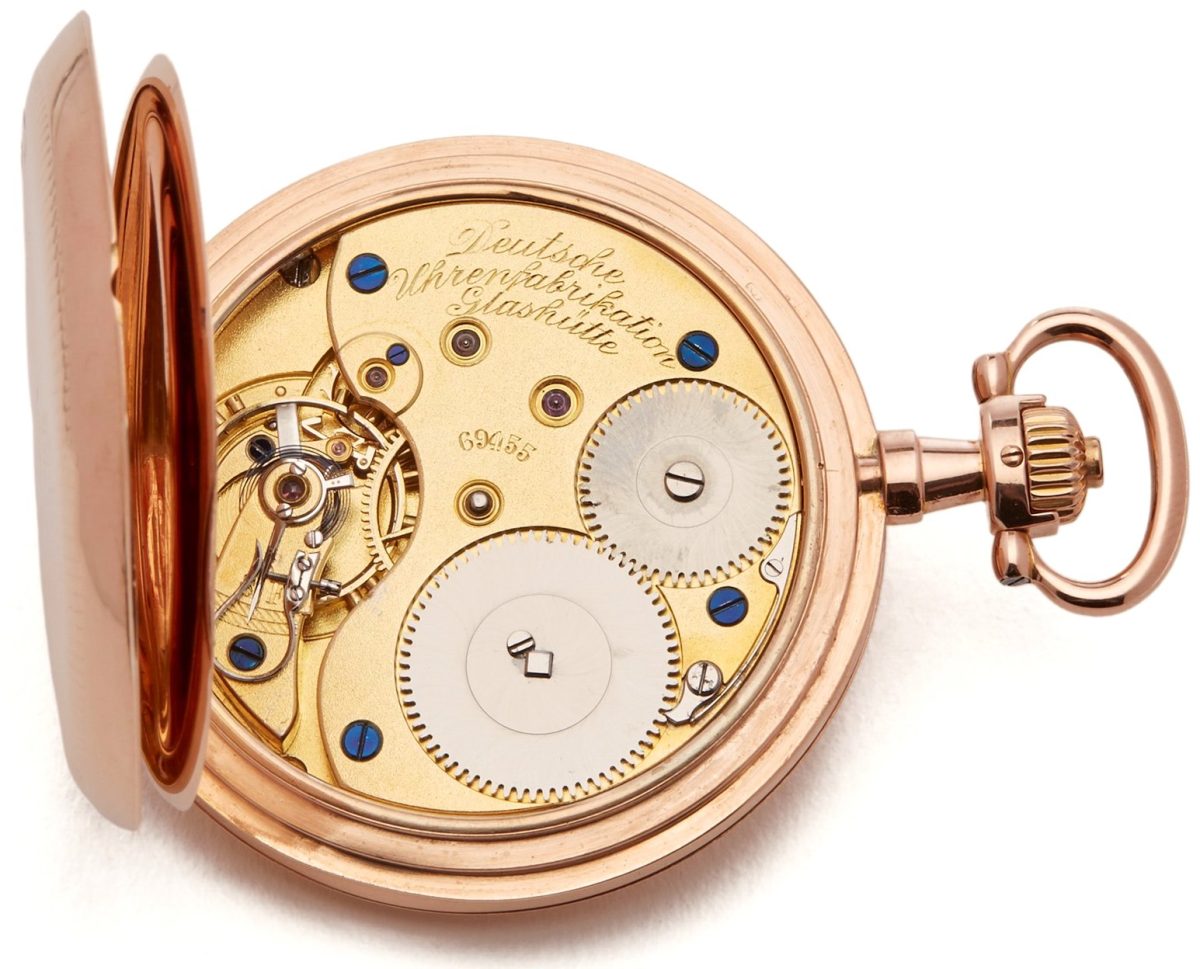
Deutsche Uhren Fabrikation movement
These watcher were made with lower quality standards compared to the 1A quality pieces, hence had a more affordable price positioning. In terms of execution and technical design, some differences between the DUF and 1A quality pieces are: a 14 carat gold housing instead of 18 carat; a ruby endstone on the balance axis instead of diamond; a plain balance bridge instead of decorated with hand engraving; balance spring in steel & brass instead of nickel; rubies set directly on the plate instead of the use of gold chatons; a gold plated brass movement plate instead of nickel silver. In addition, the caliber was adjusted to three positions instead of six and the dial and movement engravings feature “DUF” or “DUF and A. Lange & Söhne” together instead of A. Lange & Söhne alone. Despite these changes, the ‘DUF’ watches were solid, high-quality timepieces of Glashütte origin and should not be considered ‘cheap’.
During the 1880s to 1900s, A. Lange & Söhne experienced a significant surge in popularity, receiving numerous awards for both its timekeeping and aesthetics. Richard and Emil carried on their father’s legacy of innovation, and paved the way for many new patents for the company. Continued success for A. Lange & Söhne lead the company to expand the factory again in 1898. The company produced 500-600 watches per year before the duo took over. By 1892, A. Lange & Söhne created its 30,000th pocket watch. In this period, the brand began producing increasingly complicated timepieces, but also exceptionally crafted cases with engraving and enameling techniques. A highlight from this period was the impressive grande complication Ref. 42500, which was delivered in 1902. It included a perpetual calendar with a moon phase display, a split-second chronograph and a minute repeater with petite and grande sonnerie (this spectacular piece will be closer examined in a separate story). These elaborate watches are the proof that A. Lange & Söhne started to have a worldwide recognition and the clientele to accompany. A. Lange & söhne was now selling some of their timepieces for a higher price range than those offered by their Swiss competitors. In just 50 years, A. Lange & Söhne and Glashütte had realized F. A. Lange’s dream of producing some of the finest watches in the world. The brand was on the path to become a worldwide phenomenon, but the 20th century would not be as fruitful.
The Dark End (20th century)
In 1902 Otto Lange took over management of the firm, later joined by Rudolf and Ger Gerhard, representing the third generation of family ownership. The start of the 20th century brought major changes to Glashütte. The Glashütte Precision Watch Manufacture Akt was established in 1904 and followed by Nomos in 1908. These companies produced machine-made watches or imported movements from Switzerland and housed them Glashütte. Meanwhile, A. Lange & Söhne continued to make handcrafted watches using traditional methods, leading to much higher operating costs. Additionally, the rise of wristwatches was imminent, but A. Lange & Söhne had no plans to participate in this unstoppable trend.
In 1914, World War I began, and Germany was soon embroiled in a conflict that would last for four years. The war had a devastating effect on the German economy, and the watch industry suffered a lot. Hyperinflation and corporate bankruptcies left many people unemployed, which made it hard to sell high quality watches. Additionally, Germany launched a campaign to raise funds for the war by collecting gold. Many citizens participated by giving up their gold watch cases in exchange for iron ones, medals, and public recognition. Owning a gold watch was no longer socially acceptable in Germany, let alone the purchase of one. Furthermore, many of the company’s clients were now enemy soldiers, and A. Lange and Söhne lost a large percentage of its business.
In 1918, the German government nationalized all of the country’s watchmaking companies, including A. Lange and Söhne. The company was forced to produce watches for the German military, and its output further declined. After the war ended, A. Lange and Söhne was able to resume production of its luxury timepieces to some extent. However, the company was now operating in a much different political and economic climate. The global economy was in turmoil, and Germany was in the midst of an economic crisis. Inflation was rampant, and the country’s currency was virtually worthless. Furthermore, the war also brought a change in fashion, with men increasingly considering the purchase of a wrist watch like soldiers, instead of the classis pocket watch.
A. Lange & Söhne tried to adapt to the changing world, in particular regarding the growing popularity of wristwatches and lower prices due yo automatisation. The response to the later was the introduction of a new subsidiary brand called Original Lange Industry Werk (OLIW). Launched in 1925, OLIW offered a simplified version of A. Lange & Söhne watches with more easily attainable standards and a reorganized caliber optimized for faster production. It used conventional bridges rather than the three quarter plate, though they were designed to look similar. Besides gold casing, steel and silver OLIW examples were also offered. However, despite investing significant time and resources in establishing the brand, the desired success was not achieved. In light of the lackluster sales of OLIW, A. Lange & Söhne shifted its focus to producing military equipment, such as marine chronometers and pilot’s watches, for the remainder of the 1930s.
A. Lange & Söhne OLIW gold plated example
In response to the growing popularity of wristwatches, the company opted for the easy way out. This involved sourcing movements, adding their own embellishments, putting their brand on it, and selling it as an A. Lange & Söhne product. In 1927, to take advantage of Swiss expertise, A. Lange & Söhne opened a branch in Geneva. From the 1920s to the company’s fall in the 1950s, A. Lange & Söhne purchased ebauches, cases from Switzerland and Glashütte, and completed the work in their own workshops, selling them under different names like Lange Uhr, Lange Glashütte I/SA, and A. Lange & Söhne Geneva. The company, known for making pocket watches for kings and queens, became a mere industrial shadow of its former self.
As the Nazi party rose to power, A. Lange & Söhne saw a chance to provide the German military with timepieces. Following a 1933 examination by the new regime, several Glashütte firms were chosen for military agreements, with A. Lange & Söhne constructing pocket watches, marine chronometers and oversized wristwatches. But the war would cast a dark shadow over the country, including Glashütte. In September 1940, a group of 30 French prisoners of war were taken to a labor camp in Glashütte. As more Germans were drafted into the military, the use of forced labor in the town increased. By 1943, the number of forced laborers in Glashütte grew to around 3000, possibly exceeding the town’s population. There is significant evidence to suggest that these workers were mistreated, given insufficient food, and forced to work in the town’s factories.
On May 8th 1945, the very last day of World War II, A. Lange & Söhne’s manufacturing facility was caught in a bombing raid. Following the war, the company faced severe repercussions. Germany was divided into two separate parts: West Germany and East Germany. A. Lange and Söhne was located in East Germany, which was controlled by the Soviet Union with its communist regime. In 1948 the Lange family was expropriated, and the Soviet administration nationalized the company’s remaining property. For the next 45 years, the A. Lange & Söhne name disappeared and seemed destined to disappear forever.
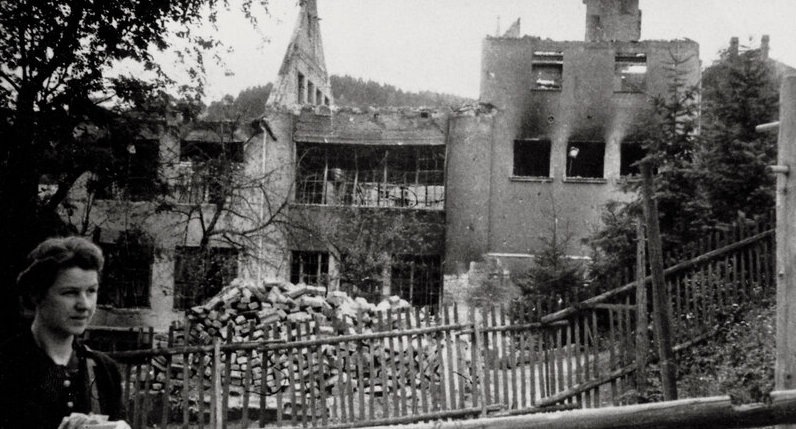
Damaged A. Lange & Söhne workshop
The Rebirth (1989)
When Rudolf Lange’s son Walter was born in 1924, the family business was facing significant challenges due to inflation and high unemployment rates. Despite the difficult circumstances, Rudolf encouraged his son to pursue watchmaking and hoped that Walter would eventually take over the business. After completing his apprenticeship in Austria in 1942, Walter was drafted into the German army and severely injured on the Russian front in 1945. He made a difficult journey back home to Glashütte, arriving on May 7, 1945, the final day of World War II, and witnessed the Russian bombing of the A. Lange & Söhne factory the following morning.
When the communist government expropriated Lange & Söhne, Walter Lange was assigned to work as a uranium miner, which he believed would be a death sentence. He fled to West Germany and attempted, with his brother Ferdinand Adolf Lange, to establish a new watch company called “Original Lange Uhr” in Pforzheim, but the venture was unsuccessful. Nonetheless, Walter continued to hold onto the dream of one day reviving the family business.
Despite the demise of the high-end watch industry in Glashütte, its legacy was still appreciated by connoisseurs such as Reinhard Reichel, Helmut Crott, Martin Huber, and Günter Blümlein, who was renowned for saving IWC and Jaeger-LeCoultre and was seeking opportunities to expand LMH’s portfolio. When the Berlin Wall fell in 1989, Blümlein saw the chance to fulfill his vision of the pinnacle of watchmaking by reviving A. Lange & Söhne.
Initially, Blümlein considered creating a joint venture with GUB manufacture, a cluster of nationalized watch manufacturers in Glashütte. However, he realized that such an initiative was impossible as GUB was too large, employing thousands of people and producing tens of thousands of watches per year. Consequently, Blümlein decided to rebuild A. Lange & Söhne from scratch.
In January 1990, two months after the fall of the Berlin Wall, Walter Lange was enjoying his retirement at the age of 66 when his phone was ringing. Walter answered and heard Günter Blümlein offering him the unbelievable: to fulfill Walter’s dream of rebuilding his family business. As astonished as Walther was, he didn’t have to think twice. After extensive discussions and creating a strategy, Walter Lange re-established the company under the name Lange Uhren GmbH on December 7th, 1990, the exact same day his great grandfather had done so 145 years before.

The première quartet of A. Lange & Söhne during the presentation in 1994
Just four years later, the company presented the first Lange collection in nearly five decades during a memorable event in the Dresden Palace. The première quartet of watches – the Lange 1, Saxonia, Arkade, and Tourbillion “Pour le Mérite” debuts – exceeded all expectations, and the announcement of the revival of the prestigious Lange brand quickly spread worldwide. The watches were a perfect blend of classic Lange quality features and innovative horological designs, making them unique and irresistibly appealing. While the Lange 1 incorporated the well-known big-date window inspired by the five-minute clock designed by Adolf Lange for the Semper Opera House in Dresden in 1830, the Pour le Mérite Tourbillon pushed the boundaries of technical innovation even further by featuring the very first fusée-and-chain mechanism in a wristwatch making it more accurate and power efficient. Today, A. Lange & Söhne is once again one of the most prestigious watchmakers in the world.


